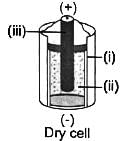All Exams >
Grade 4 >
Science for Grade 4 >
All Questions
All questions of Electricity for Grade 4 Exam
Which part of the bulb is an insulator?
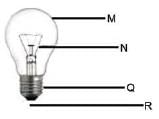
- a)Q
- b)N
- c)R
- d)M
Correct answer is option 'D'. Can you explain this answer?
Which part of the bulb is an insulator?

a)
Q
b)
N
c)
R
d)
M

|
EduRev Class 6 answered |
'M' part of the bulb is made with insulator.
Because M is the glass cover, N is the filament, Q is the supporting wires, while R is the positive terminal of the bulb.
The unit of electric current is:- a)Volt
- b)Ampere
- c)Ohm
- d)Joule
Correct answer is option 'B'. Can you explain this answer?
a)
Volt
b)
Ampere
c)
Ohm
d)
Joule
|
|
Shreyshi answered |
The unit of electric current is Ampere.
So, Option B is correct answer.
So, Option B is correct answer.
The path of electricity is called:- a)orbit
- b)filament
- c)current
- d)circuit
Correct answer is option 'D'. Can you explain this answer?
The path of electricity is called:
a)
orbit
b)
filament
c)
current
d)
circuit
|
|
Abhay Datta answered |
Explanation:
The path of electricity is known as a circuit. Let's break down why this is the correct answer:
1. Circuit:
- A circuit is a closed loop through which electricity can flow.
- It consists of various components such as wires, switches, resistors, and power sources like batteries or generators.
- When a circuit is complete, electricity can flow through it.
2. Orbit:
- An orbit typically refers to the path of an object as it revolves around another object in space, such as a planet orbiting a star.
3. Filament:
- A filament is a thin wire, often made of tungsten, found in incandescent light bulbs that heats up and produces light when an electric current passes through it.
4. Current:
- Current refers to the flow of electric charge in a circuit.
- It is measured in Amperes (A) and is essential for the operation of electrical devices.
In conclusion, the correct term for the path of electricity is a circuit because it represents the complete pathway for the flow of electric current.
The path of electricity is known as a circuit. Let's break down why this is the correct answer:
1. Circuit:
- A circuit is a closed loop through which electricity can flow.
- It consists of various components such as wires, switches, resistors, and power sources like batteries or generators.
- When a circuit is complete, electricity can flow through it.
2. Orbit:
- An orbit typically refers to the path of an object as it revolves around another object in space, such as a planet orbiting a star.
3. Filament:
- A filament is a thin wire, often made of tungsten, found in incandescent light bulbs that heats up and produces light when an electric current passes through it.
4. Current:
- Current refers to the flow of electric charge in a circuit.
- It is measured in Amperes (A) and is essential for the operation of electrical devices.
In conclusion, the correct term for the path of electricity is a circuit because it represents the complete pathway for the flow of electric current.
What happens to the current in a parallel circuit when one path is broken?- a)The entire circuit stops working
- b)Current increases
- c)Current decreases
- d)Current continues through other paths
Correct answer is option 'D'. Can you explain this answer?
What happens to the current in a parallel circuit when one path is broken?
a)
The entire circuit stops working
b)
Current increases
c)
Current decreases
d)
Current continues through other paths

|
EduRev Class 6 answered |
In a parallel circuit, each path operates independently. If one path is broken:
- The current continues to flow through the remaining paths.
- This means that other devices connected in parallel will still function.
- Only the broken path will stop conducting electricity.
This characteristic of parallel circuits ensures reliability, as the failure of one component does not disrupt the entire system.
Which of these appliances does NOT use the heating effect of electric current?- a)Electric iron
- b)Electric kettle
- c)Refrigerator
- d)Toaster
Correct answer is option 'C'. Can you explain this answer?
a)
Electric iron
b)
Electric kettle
c)
Refrigerator
d)
Toaster
|
|
Rajveer Banerjee answered |
Understanding the Heating Effect of Electric Current
The heating effect of electric current refers to the phenomenon where electrical energy is converted into heat when current flows through a conductor. This effect is utilized in various appliances, but not all appliances exploit this principle.
Appliances Using Heating Effect
- Electric Iron:
Electric irons generate heat through the resistance of the heating element when electric current passes through. This heat is used to press clothes.
- Electric Kettle:
An electric kettle heats water by converting electrical energy into heat using a heating element. This is a direct application of the heating effect of electric current.
- Toaster:
Toasters use the heating effect to brown bread. When electricity flows through the metal wires inside, they get hot enough to toast the bread.
Appliance Not Using Heating Effect
- Refrigerator:
Refrigerators operate on a different principle. They use a refrigeration cycle involving compressors and refrigerants to remove heat from the inside of the appliance, keeping it cool. While they use electricity, they do not rely on the heating effect to function.
Conclusion
In summary, among the listed appliances, the refrigerator is the only one that does not utilize the heating effect of electric current, making option 'C' the correct answer.
The heating effect of electric current refers to the phenomenon where electrical energy is converted into heat when current flows through a conductor. This effect is utilized in various appliances, but not all appliances exploit this principle.
Appliances Using Heating Effect
- Electric Iron:
Electric irons generate heat through the resistance of the heating element when electric current passes through. This heat is used to press clothes.
- Electric Kettle:
An electric kettle heats water by converting electrical energy into heat using a heating element. This is a direct application of the heating effect of electric current.
- Toaster:
Toasters use the heating effect to brown bread. When electricity flows through the metal wires inside, they get hot enough to toast the bread.
Appliance Not Using Heating Effect
- Refrigerator:
Refrigerators operate on a different principle. They use a refrigeration cycle involving compressors and refrigerants to remove heat from the inside of the appliance, keeping it cool. While they use electricity, they do not rely on the heating effect to function.
Conclusion
In summary, among the listed appliances, the refrigerator is the only one that does not utilize the heating effect of electric current, making option 'C' the correct answer.
The following diagram shows identical lamps X and Y connected in series with a battery. The lamps light with normal brightness. A third lamp Z is connected in parallel lamp X.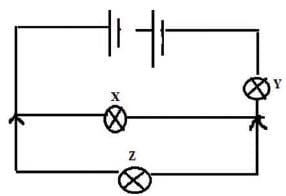 Q. What happens to the brightness of lamp Y?
Q. What happens to the brightness of lamp Y?- a)Very dim
- b)Normal
- c)Brighter than normal
- d)Dimmer than normal
Correct answer is option 'C'. Can you explain this answer?
The following diagram shows identical lamps X and Y connected in series with a battery. The lamps light with normal brightness. A third lamp Z is connected in parallel lamp X.

Q. What happens to the brightness of lamp Y?
a)
Very dim
b)
Normal
c)
Brighter than normal
d)
Dimmer than normal

|
Praveen Kumar answered |
Lamps X and Y are connected in series with a battery. If a third identical lamp Z is connected in parallel with X, then resistance of whole circuit reduces. Due to this, current drawn from battery will increase and bulb Y will be brighter than normal.
Sanchit’s mother warned him to avoid contact with electrical appliances or even electrical outlets when his hands are wet. Because wet hands cause .- a)The voltage of the circuit to be higher
- b)The voltage of the circuit to be lower
- c)Your resistance to be higher
- d)Your resistance to be lower
Correct answer is option 'D'. Can you explain this answer?
Sanchit’s mother warned him to avoid contact with electrical appliances or even electrical outlets when his hands are wet. Because wet hands cause .
a)
The voltage of the circuit to be higher
b)
The voltage of the circuit to be lower
c)
Your resistance to be higher
d)
Your resistance to be lower
|
|
Maya Deshpande answered |
Understanding Electrical Resistance
When Sanchit's mother warns him about wet hands and electrical appliances, she is highlighting a crucial aspect of electrical safety: resistance.
What is Resistance?
- Resistance is a property of materials that determines how easily electric current can flow through them.
- It is measured in ohms (Ω).
Effect of Wet Hands on Resistance
- Dry Skin Resistance: When your skin is dry, it has higher resistance, which means it is less conducive to electricity.
- Wet Skin Resistance: When your hands are wet, the moisture decreases the resistance significantly. This is because water, especially when it contains impurities (like salts), conducts electricity much better than dry skin.
Why is Lower Resistance Dangerous?
- Easier Current Flow: With lower resistance, more electric current can pass through the body if contact is made with an electrical appliance or outlet.
- Risk of Electric Shock: This increased current flow can lead to electric shocks, which can be harmful or even fatal.
Conclusion
Sanchit’s mother’s advice is rooted in the principle that wet hands lower your body's resistance to electrical current. To stay safe, it’s essential to keep your hands dry when handling electrical devices. Always prioritize safety to prevent accidents related to electricity!
When Sanchit's mother warns him about wet hands and electrical appliances, she is highlighting a crucial aspect of electrical safety: resistance.
What is Resistance?
- Resistance is a property of materials that determines how easily electric current can flow through them.
- It is measured in ohms (Ω).
Effect of Wet Hands on Resistance
- Dry Skin Resistance: When your skin is dry, it has higher resistance, which means it is less conducive to electricity.
- Wet Skin Resistance: When your hands are wet, the moisture decreases the resistance significantly. This is because water, especially when it contains impurities (like salts), conducts electricity much better than dry skin.
Why is Lower Resistance Dangerous?
- Easier Current Flow: With lower resistance, more electric current can pass through the body if contact is made with an electrical appliance or outlet.
- Risk of Electric Shock: This increased current flow can lead to electric shocks, which can be harmful or even fatal.
Conclusion
Sanchit’s mother’s advice is rooted in the principle that wet hands lower your body's resistance to electrical current. To stay safe, it’s essential to keep your hands dry when handling electrical devices. Always prioritize safety to prevent accidents related to electricity!
If we touch a naked current-carrying wire, we get a shock. This is because our body is a:- a)Source of electricity
- b)Conductor of electricity
- c)Insulator of electricity
- d)A and B both
Correct answer is option 'B'. Can you explain this answer?
If we touch a naked current-carrying wire, we get a shock. This is because our body is a:
a)
Source of electricity
b)
Conductor of electricity
c)
Insulator of electricity
d)
A and B both
|
|
Shivam Chakraborty answered |
Conductor of electricity
When we touch a naked current-carrying wire, we may experience an electric shock. This is because our body acts as a conductor of electricity. Let's understand why.
What is a conductor?
A conductor is a material that allows the flow of electric current through it easily. Metals such as copper and aluminum are good conductors of electricity. Our body contains a significant amount of water and various electrolytes, which makes it a conductor of electricity as well.
How does electricity flow?
Electricity is the flow of electrons through a conductor. In a current-carrying wire, electrons move from the negative terminal of a power source (such as a battery) towards the positive terminal. This movement of electrons creates an electric current.
Electric shock and our body as a conductor
When we touch a naked current-carrying wire, the electric current flows through our body. As our body is a conductor of electricity, the current passes through us. The severity of the shock depends on various factors like the voltage, current, and the path the current takes through our body.
Resistance and its role
Resistance is the property of a material that opposes the flow of electric current. In our body, the resistance to electric current flow is relatively high compared to metals. However, it is not high enough to prevent the flow of current completely. Therefore, we still experience an electric shock when touching a current-carrying wire.
Effects of electric shock
Electric shocks can cause various effects on our body, depending on the severity and duration of the shock. Mild shocks may cause a tingling sensation or muscle contractions, while severe shocks can lead to burns, injury, or even be life-threatening.
Precautions to avoid electric shocks
To avoid electric shocks, it is important to take certain precautions:
- Never touch naked or exposed wires.
- Always ensure electrical appliances and wiring are properly insulated.
- Use electrical safety devices like circuit breakers and residual current devices (RCDs).
- Seek professional help for electrical repairs or installations.
Conclusion
In conclusion, when we touch a naked current-carrying wire, we get a shock because our body acts as a conductor of electricity. The electric current flows through our body, causing the shock. It is important to take precautions to avoid such shocks and ensure electrical safety.
When we touch a naked current-carrying wire, we may experience an electric shock. This is because our body acts as a conductor of electricity. Let's understand why.
What is a conductor?
A conductor is a material that allows the flow of electric current through it easily. Metals such as copper and aluminum are good conductors of electricity. Our body contains a significant amount of water and various electrolytes, which makes it a conductor of electricity as well.
How does electricity flow?
Electricity is the flow of electrons through a conductor. In a current-carrying wire, electrons move from the negative terminal of a power source (such as a battery) towards the positive terminal. This movement of electrons creates an electric current.
Electric shock and our body as a conductor
When we touch a naked current-carrying wire, the electric current flows through our body. As our body is a conductor of electricity, the current passes through us. The severity of the shock depends on various factors like the voltage, current, and the path the current takes through our body.
Resistance and its role
Resistance is the property of a material that opposes the flow of electric current. In our body, the resistance to electric current flow is relatively high compared to metals. However, it is not high enough to prevent the flow of current completely. Therefore, we still experience an electric shock when touching a current-carrying wire.
Effects of electric shock
Electric shocks can cause various effects on our body, depending on the severity and duration of the shock. Mild shocks may cause a tingling sensation or muscle contractions, while severe shocks can lead to burns, injury, or even be life-threatening.
Precautions to avoid electric shocks
To avoid electric shocks, it is important to take certain precautions:
- Never touch naked or exposed wires.
- Always ensure electrical appliances and wiring are properly insulated.
- Use electrical safety devices like circuit breakers and residual current devices (RCDs).
- Seek professional help for electrical repairs or installations.
Conclusion
In conclusion, when we touch a naked current-carrying wire, we get a shock because our body acts as a conductor of electricity. The electric current flows through our body, causing the shock. It is important to take precautions to avoid such shocks and ensure electrical safety.
A potato can be used to find the polarity of a cell- a)True
- b)False
- c)Ambiguous
- d)Data insufficient
Correct answer is option 'A'. Can you explain this answer?
A potato can be used to find the polarity of a cell
a)
True
b)
False
c)
Ambiguous
d)
Data insufficient

|
Dr Manju Sen answered |
A potato is cut into two halves and the copper wires of a tester are inserted into it. After half an hour, it was noticed that there was a greenish blue spot on the potato around one wire whereas there was no such spot around the other wire. They found that it was always the wire connected to the positive terminal, which had a greenish blue spot around it. This concept could be used for identifying the positive terminal of a cell or a battery concealed in a box.
Hence, A potato can be used to find the polarity of a cell and the statement is true.
Hence, A potato can be used to find the polarity of a cell and the statement is true.
Which of these is a source of direct current (DC)?- a)Electric generator
- b)Solar cell
- c)Alternating current mains
- d)Transformer
Correct answer is option 'B'. Can you explain this answer?
a)
Electric generator
b)
Solar cell
c)
Alternating current mains
d)
Transformer
|
|
Rajveer Banerjee answered |
Understanding Direct Current (DC)
Direct current (DC) is a type of electrical current that flows in one direction only. It is commonly used in various applications, including batteries and solar cells. Let's explore the options provided to understand why a solar cell is the correct answer.
Options Analysis
- Electric Generator:
- Generators can produce both AC (alternating current) and DC, depending on their design. However, most conventional generators produce AC, which can be converted to DC using a rectifier.
- Solar Cell:
- A solar cell directly converts sunlight into electricity in the form of DC. This is the primary reason it is considered a source of DC. The output is stable and flows in one direction, making it ideal for charging batteries and powering DC devices.
- Alternating Current Mains:
- The mains electricity supply in homes typically provides AC, which alternates the direction of flow. Therefore, it cannot be classified as a source of DC.
- Transformer:
- A transformer is used to change the voltage of AC electricity. It does not generate electricity itself and only works with AC, further confirming it is not a source of DC.
Conclusion
Among the options given, the solar cell is the only one that consistently produces direct current. Its ability to convert light energy into electrical energy in one direction makes it a reliable source of DC, essential for many modern technologies.
Direct current (DC) is a type of electrical current that flows in one direction only. It is commonly used in various applications, including batteries and solar cells. Let's explore the options provided to understand why a solar cell is the correct answer.
Options Analysis
- Electric Generator:
- Generators can produce both AC (alternating current) and DC, depending on their design. However, most conventional generators produce AC, which can be converted to DC using a rectifier.
- Solar Cell:
- A solar cell directly converts sunlight into electricity in the form of DC. This is the primary reason it is considered a source of DC. The output is stable and flows in one direction, making it ideal for charging batteries and powering DC devices.
- Alternating Current Mains:
- The mains electricity supply in homes typically provides AC, which alternates the direction of flow. Therefore, it cannot be classified as a source of DC.
- Transformer:
- A transformer is used to change the voltage of AC electricity. It does not generate electricity itself and only works with AC, further confirming it is not a source of DC.
Conclusion
Among the options given, the solar cell is the only one that consistently produces direct current. Its ability to convert light energy into electrical energy in one direction makes it a reliable source of DC, essential for many modern technologies.
A device used to measure electric current is called:- a)Voltmeter
- b)Ammeter
- c)Galvanometer
- d)Thermometer
Correct answer is option 'B'. Can you explain this answer?
a)
Voltmeter
b)
Ammeter
c)
Galvanometer
d)
Thermometer

|
Learning Enablers answered |
An ammeter measures the flow of current in amperes. Voltmeters measure voltage, and galvanometers detect small currents.
The filament of an electric bulb is made of:- a)Copper
- b)Tungsten
- c)Iron
- d)Aluminium
Correct answer is option 'B'. Can you explain this answer?
a)
Copper
b)
Tungsten
c)
Iron
d)
Aluminium

|
EduRev Class 6 answered |
Tungsten is used due to its high melting point, allowing it to glow without melting when electricity passes through.
In an electric circuit, current flows from:- a)Negative terminal to positive terminal
- b)Positive terminal to negative terminal
- c)Both directions
- d)None of the above
Correct answer is option 'B'. Can you explain this answer?
a)
Negative terminal to positive terminal
b)
Positive terminal to negative terminal
c)
Both directions
d)
None of the above

|
Vp Classes answered |
Conventionally, current flows from the positive terminal to the negative terminal of a battery, even though electrons move in the opposite direction.
What type of circuit allows electricity to flow?- a)Open circuit
- b)Closed circuit
- c)Broken circuit
- d)Parallel circuit
Correct answer is option 'B'. Can you explain this answer?
a)
Open circuit
b)
Closed circuit
c)
Broken circuit
d)
Parallel circuit

|
Dr Manju Sen answered |
In a closed circuit, there is a continuous path for electricity to flow. An open or broken circuit prevents current flow.
In the circuit shown here, bulb P will glow when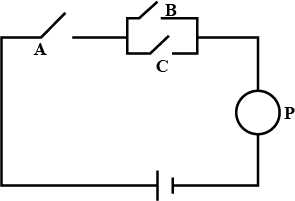
- a)A is closed, Band C are open
- b)A is closed, B is closed and C is open
- c)A is closed, Band C are closed
- d)Both B and C.
Correct answer is option 'D'. Can you explain this answer?
In the circuit shown here, bulb P will glow when

a)
A is closed, Band C are open
b)
A is closed, B is closed and C is open
c)
A is closed, Band C are closed
d)
Both B and C.

|
Rohini Seth answered |
In the circuit here, bulb P will glow when the circuit is complete.
The circuit should not be broken at any point.It should be continous at every point.
At A only one path is present so A has to be closed in every situation.
But from B and C even if one switch is closed the circuit will be complete.And in case both B and C are closed even then the circuit will be complete.
Thus answers are:
The circuit should not be broken at any point.It should be continous at every point.
At A only one path is present so A has to be closed in every situation.
But from B and C even if one switch is closed the circuit will be complete.And in case both B and C are closed even then the circuit will be complete.
Thus answers are:
- A closed, B closed and C open. OR
- A closed ,B and C both closed.
Thus, both option (B) and (C) are correct.
Correct option - (D).
Correct option - (D).
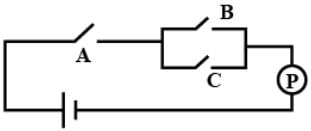
Which of the following is NOT an effect of electric current?- a)Heating effect
- b)Magnetic effect
- c)Sound effect
- d)Chemical effect
Correct answer is option 'C'. Can you explain this answer?
a)
Heating effect
b)
Magnetic effect
c)
Sound effect
d)
Chemical effect

|
Learning Enablers answered |
Electric current causes heating, magnetic, and chemical effects, but sound is not a direct effect of current.
Which of these is an example of a closed circuit?- a)A circuit with a broken wire
- b)A circuit with a switch turned on
- c)A circuit without a battery
- d)A circuit with an open switch
Correct answer is option 'B'. Can you explain this answer?
a)
A circuit with a broken wire
b)
A circuit with a switch turned on
c)
A circuit without a battery
d)
A circuit with an open switch

|
Dr Manju Sen answered |
When the switch is on, the circuit is closed, allowing current to flow. Broken wires or open switches result in incomplete circuits.
Which device is used to open or close an electric circuit?- a)Bulb
- b)Battery
- c)Switch
- d)Resistor
Correct answer is option 'C'. Can you explain this answer?
a)
Bulb
b)
Battery
c)
Switch
d)
Resistor

|
EduRev Class 6 answered |
A switch controls the flow of current by opening (breaking) or closing (completing) the circuit.
What happens to the bulb when the circuit is incomplete?- a)The bulb glows brightly
- b)The bulb glows dimly
- c)The bulb does not glow
- d)The bulb explodes
Correct answer is option 'C'. Can you explain this answer?
a)
The bulb glows brightly
b)
The bulb glows dimly
c)
The bulb does not glow
d)
The bulb explodes

|
Vp Classes answered |
A complete (closed) circuit is required for current to flow and light the bulb. Incomplete circuits stop the flow of electricity.
The given diagram is a torch containing cells. The torch is not glowing when the switch is ON. Now, it is opened to know the reasons. Which of the following statements are correct regarding the reasons?
(i) Bulb of the torch is fused.
(ii) Cells are not connected properly.
(iii) The metal parts of the torch do not make proper contact with the cell.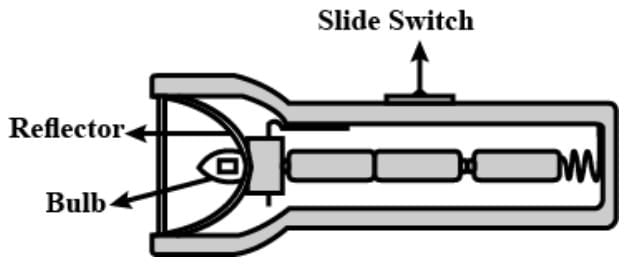
- a)Only (i) and (ii)
- b)Only (ii) and (iii)
- c)Only (i) and (iii)
- d)All (i), (ii) and (iii)
Correct answer is option 'D'. Can you explain this answer?
The given diagram is a torch containing cells. The torch is not glowing when the switch is ON. Now, it is opened to know the reasons. Which of the following statements are correct regarding the reasons?
(i) Bulb of the torch is fused.
(ii) Cells are not connected properly.
(iii) The metal parts of the torch do not make proper contact with the cell.
(i) Bulb of the torch is fused.
(ii) Cells are not connected properly.
(iii) The metal parts of the torch do not make proper contact with the cell.

a)
Only (i) and (ii)
b)
Only (ii) and (iii)
c)
Only (i) and (iii)
d)
All (i), (ii) and (iii)

|
Vp Classes answered |
The torch is not glowing because either its bulb is fused or cells are connected wrongly or metal spring of torch does not make proper contact with the cell.
What is the main function of a fuse in an electric circuit?- a)To switch the circuit on and off
- b)To measure current
- c)To prevent overloading
- d)To increase current
Correct answer is option 'C'. Can you explain this answer?
a)
To switch the circuit on and off
b)
To measure current
c)
To prevent overloading
d)
To increase current

|
Shiksha Academy answered |
A fuse melts when excessive current flows, breaking the circuit and preventing damage to devices or fire hazards.
A material that allows electricity to flow easily is called a:- a)Conductor
- b)Insulator
- c)Semiconductor
- d)Resistor
Correct answer is option 'A'. Can you explain this answer?
a)
Conductor
b)
Insulator
c)
Semiconductor
d)
Resistor

|
Dr Manju Sen answered |
Conductors like metals permit the flow of electric current due to their free electrons.
Which part of the electric circuit provides energy to the circuit?- a)Bulb
- b)Switch
- c)Battery
- d)Wires
Correct answer is option 'C'. Can you explain this answer?
a)
Bulb
b)
Switch
c)
Battery
d)
Wires

|
Dr Manju Sen answered |
A battery stores chemical energy and converts it into electrical energy, supplying power to the circuit.
Which of the following is a good conductor of electricity?- a)Plastic
- b)Glass
- c)Copper
- d)Rubber
Correct answer is option 'C'. Can you explain this answer?
a)
Plastic
b)
Glass
c)
Copper
d)
Rubber

|
Dr Manju Sen answered |
Copper allows electricity to pass through easily due to the free movement of electrons, making it a good conductor. Plastic, glass, and rubber are insulators.
Which of these materials is an insulator?- a)Iron
- b)Aluminium
- c)Wood
- d)Copper
Correct answer is option 'C'. Can you explain this answer?
a)
Iron
b)
Aluminium
c)
Wood
d)
Copper

|
Shiksha Academy answered |
Insulators like wood do not allow electricity to pass through. Metals such as iron and aluminium are good conductors.
Electricity is the flow of:- a)Atoms
- b)Protons
- c)Neutrons
- d)Electrons
Correct answer is option 'D'. Can you explain this answer?
a)
Atoms
b)
Protons
c)
Neutrons
d)
Electrons

|
EduRev Class 6 answered |
Electricity is the movement of electrons (negative charges) through a conductor.
In a series circuit, if one bulb is removed or burns out:- a)The other bulbs continue to glow
- b)The circuit becomes incomplete
- c)The brightness of other bulbs increases
- d)The brightness of other bulbs decreases
Correct answer is option 'B'. Can you explain this answer?
a)
The other bulbs continue to glow
b)
The circuit becomes incomplete
c)
The brightness of other bulbs increases
d)
The brightness of other bulbs decreases

|
EduRev Class 6 answered |
In a series circuit, all components are connected in a single path. If one component fails, the entire circuit stops working.
Which of the following is the symbol for a battery in a circuit diagram?- a)A single line
- b)A rectangle
- c)Two parallel lines of different lengths
- d)A zigzag line
Correct answer is option 'C'. Can you explain this answer?
a)
A single line
b)
A rectangle
c)
Two parallel lines of different lengths
d)
A zigzag line

|
Dr Manju Sen answered |
A battery is represented by two parallel lines, where the longer line represents the positive terminal and the shorter line the negative terminal.
Chapter doubts & questions for Electricity - Science for Grade 4 2025 is part of Grade 4 exam preparation. The chapters have been prepared according to the Grade 4 exam syllabus. The Chapter doubts & questions, notes, tests & MCQs are made for Grade 4 2025 Exam. Find important definitions, questions, notes, meanings, examples, exercises, MCQs and online tests here.
Chapter doubts & questions of Electricity - Science for Grade 4 in English & Hindi are available as part of Grade 4 exam.
Download more important topics, notes, lectures and mock test series for Grade 4 Exam by signing up for free.
Science for Grade 4
26 videos|122 docs|37 tests
|

Contact Support
Our team is online on weekdays between 10 AM - 7 PM
Typical reply within 3 hours
|
Free Exam Preparation
at your Fingertips!
Access Free Study Material - Test Series, Structured Courses, Free Videos & Study Notes and Prepare for Your Exam With Ease

 Join the 10M+ students on EduRev
Join the 10M+ students on EduRev
|

|
Create your account for free
OR
Forgot Password
OR
Signup on EduRev and stay on top of your study goals
10M+ students crushing their study goals daily

